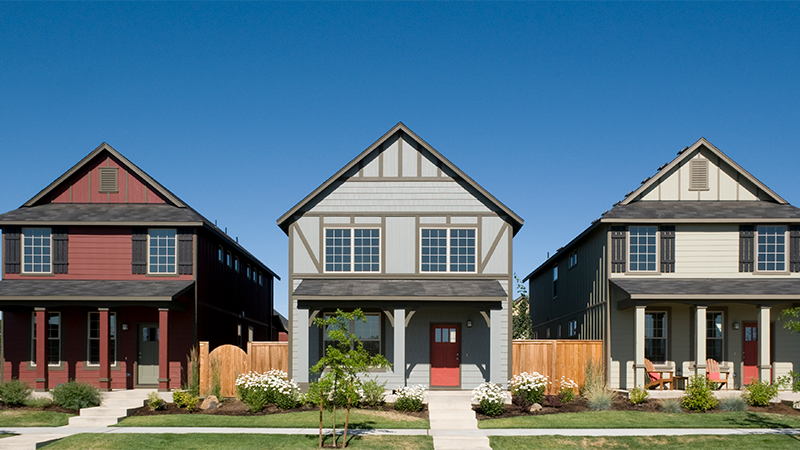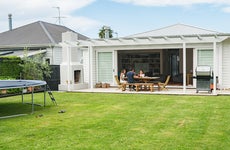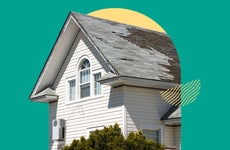Types of homeowners insurance

The Bankrate promise
At Bankrate, we strive to help you make smarter financial decisions. To help readers understand how insurance affects their finances, we have licensed insurance professionals on staff who have spent a combined 47 years in the auto, home and life insurance industries. While we adhere to strict , this post may contain references to products from our partners. Here's an explanation of . Our content is backed by Coverage.com, LLC, a licensed entity (NPN: 19966249). For more information, please see our .
Key takeaways
- The most common type of homeowners insurance policy is the standard HO-3 policy.
- HO-5 policies offer the broadest coverage of all policy types.
- Open peril coverage means losses are covered unless specifically excluded, while named peril coverage means only named loss types are covered.
Homeowners insurance is not a single policy type; consumers have eight types of home insurance policies to choose from when purchasing coverage. While some policies are tailored to specific types of homeowners or renters, others allow the homeowner to personalize what coverage they want. Before you purchase or renew a policy, ensure you understand all your options. To make it easier, Bankrate’s insurance editorial team explores the pros and cons of each coverage type so you can make an informed decision.
HO–1
An HO-1 is the most basic homeowners insurance policy. It only provides coverage for the structure of your home, attached structures like garages and appliances and home features like carpeting. It does not include coverage for personal property, liability or additional living expenses. Because of those limitations, it is not as popular as more robust policy options.
HO-1 insurance is a named perils policy, meaning it only covers your home in specific loss events, which typically include:
- Damage from aircrafts or vehicles
- Explosions
- Fire and lightning
- Hail and windstorms
- Riots
- Smoke
- Theft
- Vandalism
- Volcanic eruption
With an HO-1 policy, your home, attached structures, appliances and home features will only be protected if they are damaged from one of the perils that is specifically listed in your policy. If they incur damage from anything else, you will be unable to file a claim with your home insurance company and would need to pay for the repairs out of pocket. It is worth noting that an HO-1 policy does not include liability, loss of use coverage or medical payments coverage, which are part of standard home policies. Because coverage is so limited, many insurers do not write this type of policy.
Learn more: HO-1 insurance
HO–2
An HO-2 insurance policy is also known as a broad form and covers your home and your personal belongings. Most home insurance companies will cover your personal belongings up to a specified level if they are at home, in your car or somewhere else, such as an offsite storage facility. HO-2 policies may include liability coverage in some circumstances. To determine if your HO-2 policy includes liability coverage, contact your insurance carrier directly.
Like an HO-1 policy, HO-2 insurance is a named perils policy that covers your home and your personal items from the losses that are listed out in your policy. Typically, the losses found in an HO-2 policy are similar to the ones in an HO-1, but may include a few additional ones:
- Accidental discharge or overflow of water or steam within the home
- A falling object
- Freezing of pipes and heating and air conditioning systems
- Sudden and accidental damage from certain electrical currents
- Tearing apart, burning, cracking from some household systems
- Weight from ice, snow or sleet
Learn more: HO-2 insurance
HO-3
The most common type of homeowners insurance is the HO-3 policy, which covers your home, your personal property, liability, additional living expenses and medical payments. Unlike an HO-1 and HO-2 policy, your home and attached structures are protected on an open-peril basis; they are protected from all kinds of losses except the ones that are specifically excluded from your policy.
Personal finance and insurance expert Laura Adams says, “An HO-3 is considered the standard coverage. It gives you ‘open perils’ coverage for your home structure, which protects you from all disasters unless the policy lists exceptions. However, you receive ‘named perils’ coverage for personal possessions, which applies to disasters named in the policy.”
Your home and other structures typically have the following perils excluded:
- Any animals owned by the insured
- Birds, rodents, varmint
- Defective construction or maintenance
- Earth movement
- Flood
- Foundation issues
- Government actions
- Intentional loss
- Mechanical breakdown
- Mold, fungus, wet rot
- Neglect
- Nuclear hazard
- Ordinance or law
- Pet or animal damage
- Pollution and corrosion
- Power failure
- Smog, rust, or corrosion
- Theft, vandalism and frozen pipes in vacant houses
- Wear and tear
- War and surrection
Although floods and earthquakes are not covered by a standard HO-3 policy, you may be able to get an endorsement or separate flood insurance or earthquake policy to meet these coverage needs.
- Damage from aircrafts or vehicles
- Damage from the weight of snow or ice
- Damages caused by an electrical current
- Explosions
- Falling objects
- Fire and lightning
- Hail and windstorms
- Pipes freezing
- Riots
- Smoke
- Theft
- Vandalism
- Volcanic eruptions
- Water damage from plumbing or HVAC overflow
- Water heater damage
Learn more: HO-3 insurance
HO–4
An HO-4 policy, also known as renters insurance, is intended for renters who want to insure their personal belongings and get additional coverage, like liability and additional living expenses. An HO-4 is not technically a “homeowners” policy, as renters don’t own the property where they are living, which is why this policy type excludes coverage for the building’s structure whether it is a single-family home or multi-family structure like an apartment building. Renters would need to purchase separate coverage for flood and earthquake damage.
Renters insurance policies are usually named perils policies that cover the following events:
- Damage from aircrafts or vehicles
- Damage from the weight of snow or ice
- Damages caused by an electrical current
- Explosions
- Falling objects
- Fire and lightning
- Hail and windstorms
- Pipes freezing
- Riots
- Smoke
- Theft
- Vandalism
- Volcanic eruptions
- Water damage from plumbing or HVAC overflow
- Water heater damage
Learn more: HO-4 insurance
HO–5
An HO-5 policy is the most robust option available, covering your home, your personal belongings, liability, additional living expenses and medical payments for others. These policies may also have higher available limits for things like jewelry compared to the more common HO-3 policy. However, not all home insurers offer HO-5 policies and not all homeowners will be able to purchase an HO-5 policy due to the strict qualification guidelines.
Adams discusses how an HO-5 policy could be beneficial for individuals with high-value items. She says, “It typically costs more and may not be offered by every insurer but could be worth it if you have many valuable possessions.”
With an HO-5 policy, your home and your personal items are both covered on an open perils basis. Some common exclusions include:
- Earth movement
- Government actions or laws
- Infestation of birds, rodents or insects
- Intentional loss
- Mechanical breakdown
- Mold
- Nuclear hazard
- Pets
- Vandalism if the property is vacant more than two months
- War and surrection
- Water damages from floods or sewer backup
Because an HO-5 policy is written on an open perils basis rather than on a named perils basis, it covers more circumstances and can make it easier to get coverage when you file a claim. Because of its high level of protection, an HO-5 policy is usually more expensive than a standard HO-3.
Learn more: HO-5 insurance
HO–6
HO-6 insurance is specifically for condo owners. It covers everything inside your unit, as well as personal liability and additional living expenses. Condo policies also typically include some dwelling coverage, as condo owners may be responsible for the interior walls of their units. It is important to have enough coverage in your condo policy to not only pay off your mortgage, but to purchase a similar unit if your building is damaged or destroyed and you need to move elsewhere. For flood and earthquake coverage, separate coverage would need to be purchased.
Because condo residents only own their unit, and not the whole building, the condo association typically has a master insurance policy that protects common areas, grounds and external parts of the building. Condo owners generally help pay for the association’s insurance in the form of condo or HOA fees.
HO-6 policies are named perils policies that generally cover:
- Damage from aircrafts or vehicles
- Damage from the weight of snow or ice
- Damages caused by an electrical current
- Explosions
- Falling objects
- Fire and lightning
- Hail and windstorms
- Pipes freezing
- Riots
- Smoke
- Theft
- Vandalism
- Volcanic eruptions
- Water damage from plumbing or HVAC overflow
- Water heater damage
Learn more: HO-6 insurance
HO–7
An HO-7 insurance policy covers mobile or manufactured homes, including trailers, sectional homes, RVs and modular homes. This type of policy provides coverage for your home’s structure, your personal belongings, liability, additional living expenses and medical payments. Flood and earthquake coverage would need to be purchased separately.
The exterior of your home is covered under an open perils policy, which covers any situation that is not explicitly stated in your insurance policy.
However, HO-7 policies cover your personal belongings under a named perils policy. That means your personal items are only covered under a specific list of circumstances, including:
- Damage from aircrafts or vehicles
- Explosions
- Fire and lightning
- Hail and windstorms
- Riots
- Smoke
- Theft
- Vandalism
HO–8
The last type of homeowners insurance is the HO-8 policy, which is likely ideal for homeowners who have older homes or homes that would be more difficult to replace. This includes architecturally significant houses, historic landmark homes or homes built with materials and methods that are not common today. If it would cost more to repair your damaged home than its current value, an HO-8 policy may be a suitable option.
HO-8 policies include the standard coverage for dwelling, personal property, liability, additional living expenses and medical payments. Both your home’s structure and your personal property are covered under a named perils policy. This includes events such as:
- Damage from aircraft or vehicles
- Explosions
- Fire and lightning
- Hail and windstorms
- Riots
- Smoke
- Theft
- Vandalism
- Volcanic eruption
Like a standard home policy, flood and earthquake coverage would need to be purchased separately.
Frequently asked questions
-
Bankrate’s insurance editorial team analyzed average rate data to identify some of the cheapest home insurance companies in the nation, but the best way to find the cheapest insurance carrier for you is likely to compare quotes from multiple carriers. Your home insurance premiums could vary depending on your coverage selections, risk factors in your area, deductible amount and more. The type of policy you choose can also factor in the cost of your home insurance. To put it simply, the less protection your policy offers, the lower your premium will be. But, bear in mind that a policy with less protection may leave you more exposed financially. If your home is damaged from something not covered by your policy, you could be stuck with exorbitant out-of-pocket costs.
-
The price of homeowners insurance varies from person to person as location, home size, home age and other factors all go into determining your rate. To give you an idea of what you might pay, note that the average U.S. homeowner pays an average of $2,151 for $300,000 in dwelling coverage per year. Home insurance prices in your state might vary, but you can find out rates in your area by speaking with neighbors and gathering personal quotes. Remember that comparing quotes is one of the best ways to save on home insurance costs.
-
There are eight types of home insurance. They are classified as HO-1 through HO-8. Each category is designed for a different type of home with its own coverage types.
-
Whether your homeowners insurance is named peril or open peril depends on the policy type you purchase. As a policyholder, you are generally not able to amend the policy terms, but you may be able to turn down specific coverage options in writing. As such, it may be beneficial to speak with a knowledgeable licensed agent in your area. You almost always have the option to purchase policy endorsements to round out your protection.
-
Home insurance is not legally required at the state or federal level, but it is likely a requirement from your financial institution if you have a mortgage loan or lien on your home. Even if you own your home outright, a homeowners insurance policy could still be useful in protecting your finances. In the event of a total or significant covered loss, you wouldn’t need to pay the full cost of repairs out-of-pocket.
-
Home insurance is not one-size-fits all. There are several policy types and each homeowner has different policy needs. Some policy types are tailored to specific needs. For example, a renter will likely need an HO-4 policy while mobile homeowners may require an HO-7. However, even within policy types, homeowners have more choice when it comes to coverage options.
It helps to determine what coverage you want or need in your policy ahead of your search. It can also help to assess your budget before you begin shopping around to understand the level of coverage you can afford. As you research policies and request quotes, look for providers that offer the coverage you need for your home and personal property at a rate that makes sense for you. Keep in mind that providers often offer endorsements that you can add to basic homeowners policies. If you’re unsure what type of home insurance to purchase, consider working with a licensed insurance agent.
-
Insurers and agents have tools to determine adequate replacement cost coverage for your home. However, if you have not updated your policy recently, you may have a significant shortfall in your dwelling coverage limit. Research from the Insurance Information Institute showed that replacement costs increased a cumulative 55 percent between 2019–2022, nearly four times the U.S. inflation rate, due to escalating costs of construction materials and labor shortages.
Related Articles



